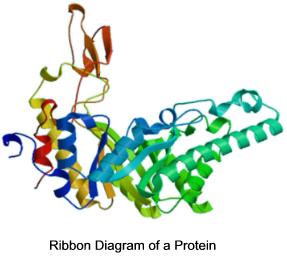Overview |
Diffraction | Crystal Quality | Facilities |
| Home |
Proteins |
| Neural Networks |
What Are Proteins?

Proteins consist of chains of amino acids whose attractive and repulsive forces have bent them into complicated three-dimensional molecules. The intricate structures of proteins form the enzymes, cell linings, receptors, organelles and other biological machinery that keep us alive. Intrinsic to the operation of a protein is this three-dimensional structure. It defines how the protein will interact with other molecules, both natural and foreign. Determining the structure of a protein provides an invaluable piece of the puzzle for creating new medications. For example, suppose that a hole in a certain protein caused Alzheimer’s disease. If the three-dimensional structure of the protein was known, a chemical could be developed that would bind to the hole and solve the problem. This method has been very successful in the development of new medications. The procedure for determining the three-dimensional structure of proteins is called protein crystallography.